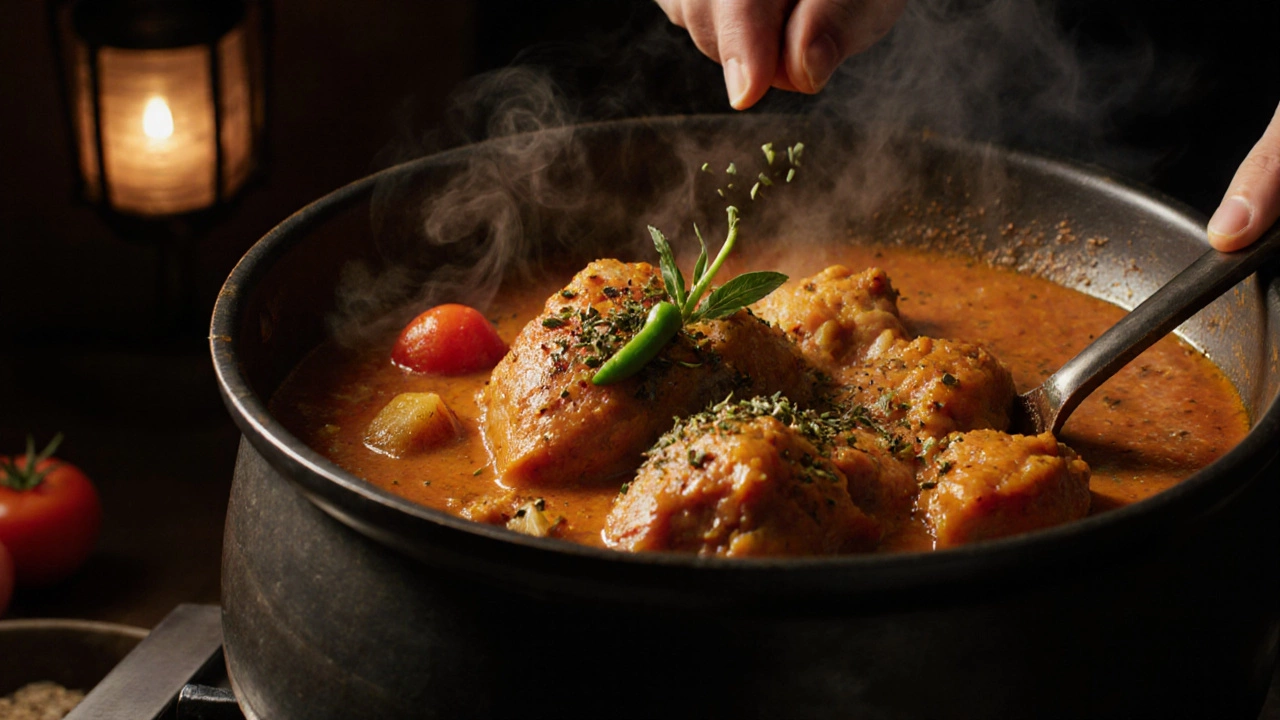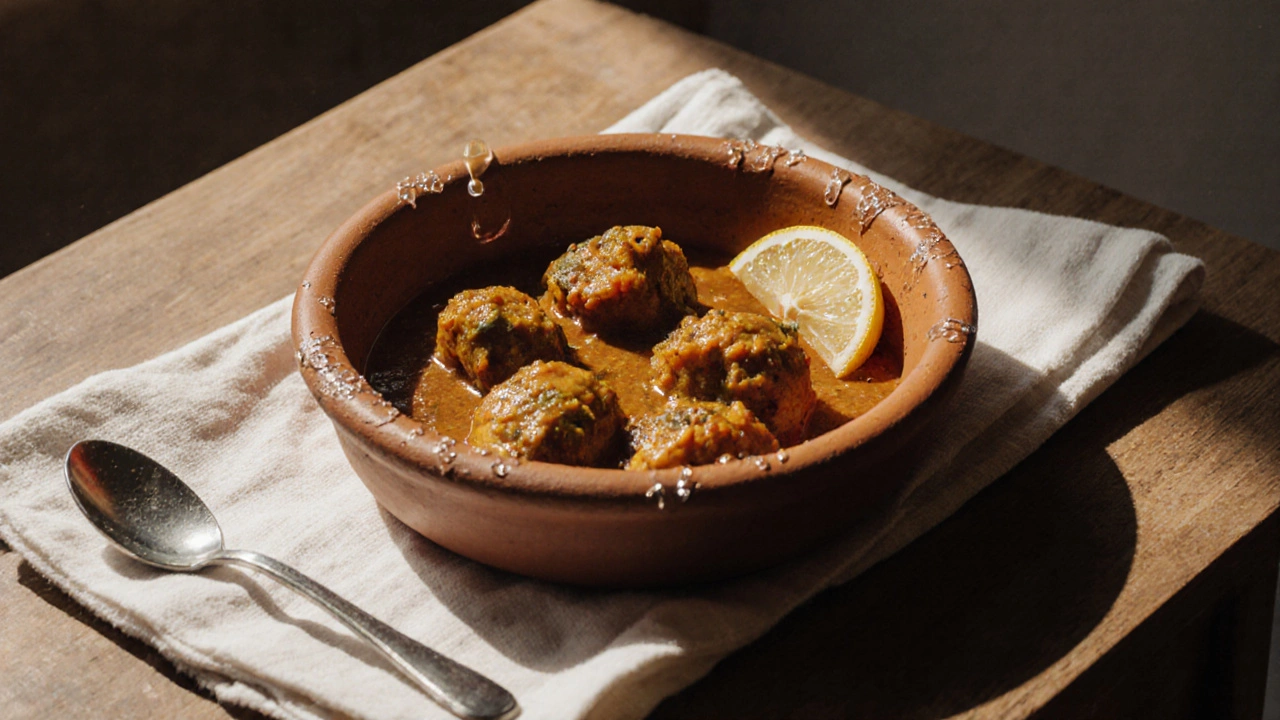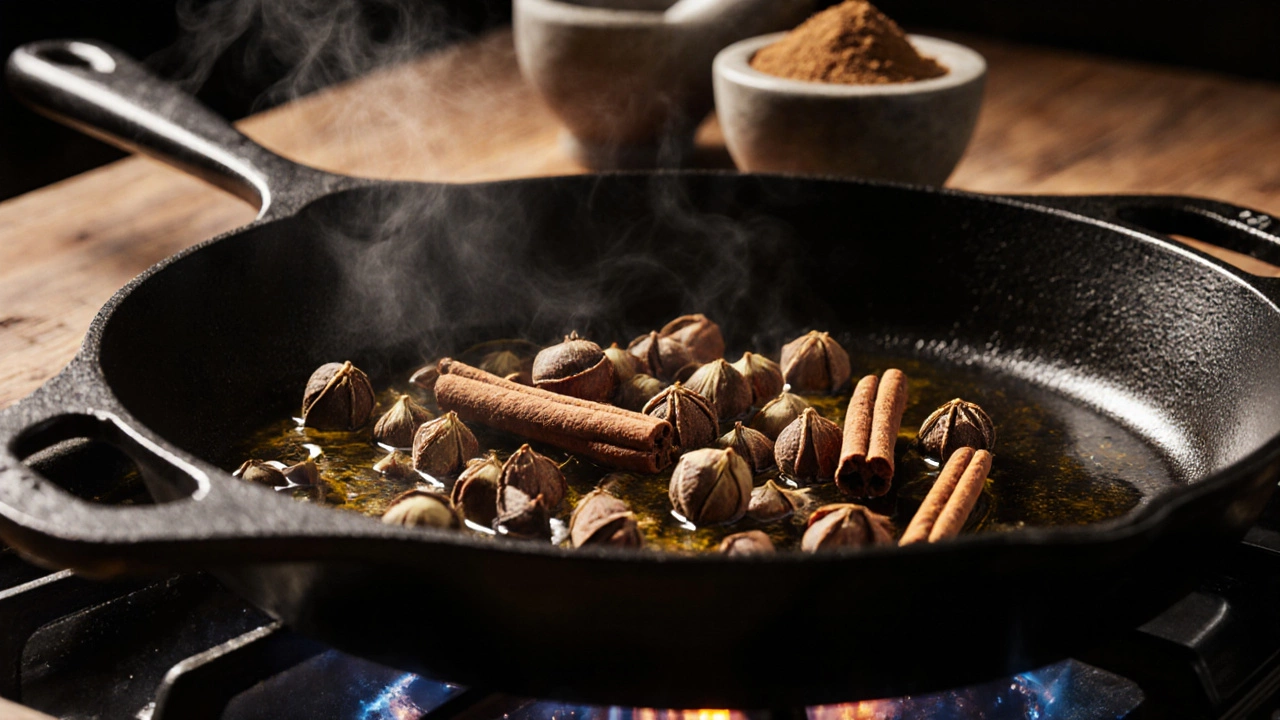18 Nov 2025
- 0 Comments
Chicken Curry Flavor Calculator
Fix Your Bland Curry
Recommended Ingredients
Enter your chicken quantity and flavor preferences to see ideal proportions.
If your chicken curry tastes flat, watery, or just plain boring, you’re not alone. Too many people follow recipes to the letter and end up with a dish that’s forgettable. The problem isn’t the chicken or the sauce-it’s the spice. Flavor doesn’t come from just throwing powder into a pot. It comes from layering, timing, and technique. Here’s how to fix a bland chicken curry and turn it into something people ask for seconds of.
Start with fresh spices, not old ones
Ground spices lose their punch fast. Cumin, coriander, turmeric, and garam masala don’t last forever. If your spices have been sitting in the cupboard since last Diwali, they’re probably dust. Fresh spices smell aromatic-earthy, warm, slightly sweet. Old ones smell like nothing. Test yours: rub a pinch between your fingers. If you don’t smell anything, toss them. Buy whole spices instead. Toast cumin seeds, cardamom pods, and cinnamon sticks in a dry pan for 30 seconds until they crackle and release their oil. Then grind them fresh. It makes a huge difference. A 2023 study from the Indian Institute of Food Processing Technology found that freshly ground spices delivered 40% more volatile flavor compounds than pre-ground versions stored over six months.Bloom your spices in oil
Don’t just dump spices into the curry at the end. That’s like putting sugar in your coffee after you’ve already drunk it. You need to bloom them. Heat 2 tablespoons of oil or ghee in your pot until it shimmers. Add whole spices first-bay leaves, cloves, black peppercorns, mustard seeds. Let them sizzle for 10 seconds. Then add ground spices: turmeric, cumin, coriander, chili powder. Stir constantly for 30 to 45 seconds. The oil will turn bright yellow, and the smell will fill the kitchen. This step activates the oils in the spices and unlocks their full flavor. Skip this, and your curry will taste like cardboard with a hint of dust.Use real tomatoes, not paste
Canned tomato paste is convenient, but it’s often salty, overly processed, and lacks brightness. Fresh tomatoes-peeled, seeded, and chopped-bring acidity, sweetness, and body. Cook them down slowly with the spices. Let them break apart and caramelize slightly. You’ll get a richer, deeper base. If you’re short on time, use high-quality canned San Marzano tomatoes. Drain the juice, crush them by hand, and add them to the pot. Avoid tomato sauce with added sugar or herbs. Those are flavor killers in a traditional curry.
Build depth with aromatics
Onions, garlic, and ginger aren’t just background players-they’re the foundation. Slice onions thin and cook them low and slow until they turn golden brown, not just translucent. That’s where the sweetness comes from. Then add minced garlic and grated ginger. Cook until the raw smell disappears and the mixture smells sweet and nutty. This step takes 8 to 10 minutes. Rush it, and your curry will taste raw and one-dimensional. In Indian home kitchens, this is called the base masala. It’s non-negotiable.Finish with acidity and heat
A bland curry often lacks contrast. You need something bright to cut through the richness. A squeeze of lemon juice or a splash of tamarind pulp added right before serving lifts everything. Try 1 teaspoon of tamarind paste or 1 tablespoon of fresh lime juice. Taste. Add more if needed. Heat matters too. Raw chili powder doesn’t give the same kick as fresh green chilies. Slit one or two Thai bird’s eye chilies and add them whole during cooking. They infuse flavor without making the curry too spicy. Remove them before serving if you want mild heat. Or, stir in a spoonful of green chili paste at the end for a fresh, fiery punch.Don’t forget the finishing touches
The last 5 minutes are where magic happens. Stir in a tablespoon of butter or ghee-it adds silkiness and rounds out sharp edges. Sprinkle in a pinch of kasuri methi (dried fenugreek leaves). Crush them between your fingers before adding. They smell like hay and give curry a restaurant-quality depth. A dash of sugar (just 1/4 teaspoon) can balance acidity if your tomatoes are too tart. And never, ever add salt too early. Wait until the end. Salt pulls moisture out of the chicken and can make it tough. Add it in the last 2 minutes, taste, and adjust.
Let it rest
Curry isn’t done when you turn off the stove. It needs time. Cover it and let it sit for 20 to 30 minutes. The flavors meld. The chicken soaks up the sauce. The spices settle into a harmonious balance. Reheat gently before serving. This step separates a good curry from a great one. Restaurants do this. Home cooks skip it. That’s why your curry tastes flat.What not to do
Don’t add cream or coconut milk to fix blandness. That just masks the problem with fat. Don’t dump in more curry powder. That’s like adding more salt to a soup that’s too bland-it makes it worse. Don’t use pre-made curry pastes from a jar unless you know the ingredients. Most are loaded with preservatives and sugar. And don’t believe the myth that longer cooking = more flavor. Overcooking chicken turns it rubbery. Simmer gently for 20 minutes max after adding the chicken.Quick Flavor Boost Checklist
- Use fresh, ground spices (or grind whole ones yourself)
- Bloom spices in hot oil for 45 seconds
- Cook onions until golden brown, not just soft
- Use fresh tomatoes, not paste
- Add lemon juice or tamarind at the end
- Stir in kasuri methi and a knob of butter
- Let the curry rest for 20 minutes before serving
Fixing a bland chicken curry isn’t about adding more spices. It’s about doing the right things at the right time. It’s about patience, technique, and respect for the ingredients. Try these steps next time. You’ll taste the difference before the first bite.
Why does my chicken curry taste watery?
Watery curry usually means you didn’t cook down the tomatoes or onions enough. Let them simmer slowly until the oil separates from the sauce-that’s your sign the water has evaporated and the flavors are concentrated. Also, avoid adding too much water or stock. Use just enough to cover the chicken, then let it reduce naturally.
Can I use store-bought curry powder instead of individual spices?
You can, but it’s not ideal. Most commercial curry powders are blends with low-quality, stale spices and fillers like flour or turmeric. They lack depth and complexity. If you must use it, bloom it in oil first and add extra fresh garlic, ginger, and chili to compensate. Better yet, buy whole spices and make your own blend.
What’s the best chicken to use for curry?
Bone-in, skin-on chicken thighs are best. They stay juicy and add richness to the sauce as they cook. Chicken breast dries out easily and gives a bland texture. If you prefer breast meat, cut it into large pieces, sear it quickly before adding to the curry, and cook it only until just done.
How do I make my curry thicker without flour?
Simmer it longer to reduce the liquid. You can also mash a small boiled potato into the sauce-it thickens naturally and adds subtle sweetness. Ground cashews or coconut milk (used sparingly) also work. Avoid cornstarch or flour; they create a pasty texture that doesn’t belong in traditional curry.
Is yogurt a good addition to chicken curry?
Yes, but only if you add it right. Stir in 2 tablespoons of plain, full-fat yogurt at the end, off the heat. If you add it while the curry is boiling, it will curdle. Yogurt adds tang and creaminess without heaviness. It’s a traditional trick in North Indian cooking.
